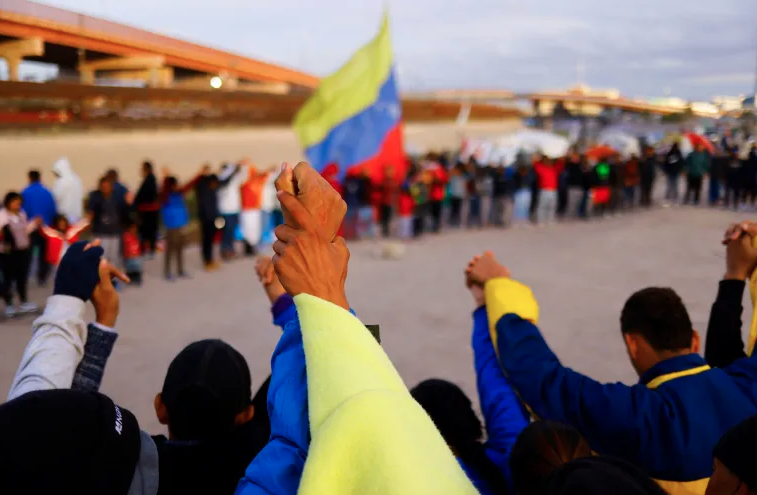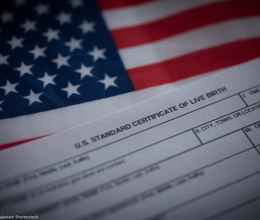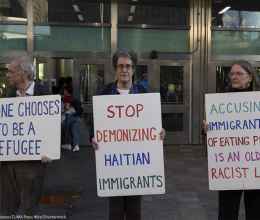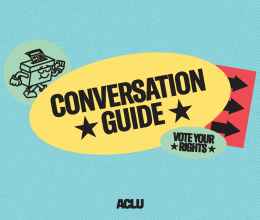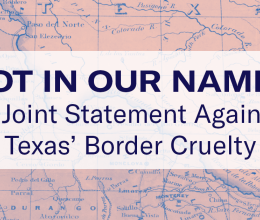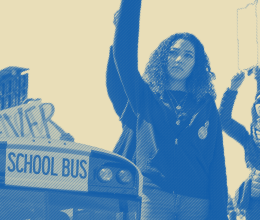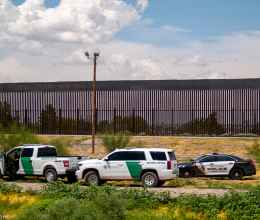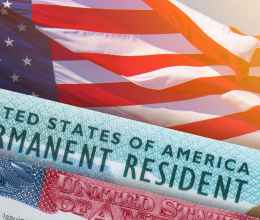A.KENDALL CIESEMIER [00:00:01] From the ACLU, This is At Liberty. I’m Kendall Ciesemier, your host. As soon as a week from today, the Biden administration could implement a policy change that would force people to seek asylum and wait for an answer in Mexico or another country they passed through with limited exceptions. The proposed change is based off of a Trump era policy that the ACLU fought in court and which President Biden previously condemned. It also stands in direct violation of the United States asylum laws and will lead people fleeing violence and persecution to face avoidable harm. President Biden campaigned on promises to restore and strengthen the asylum process. Instead of recommitting the United States to its promises of upholding international humanitarian practices, his administration plans to replace the inhumane Title 42 policy enacted under the Trump administration with a similarly dangerous one taken straight from the Trump playbook. Two experts join us today to unpack this rule and the harm it will cause thousands of people and to explain what the silent process should look like. For Blaine Bookey, legal director of the Center for Gender and Refugee Studies, this rule adds another layer of pain and suffering to the experience of seeking asylum in America. It will hurt people who have already been persecuted, those who are simply looking for a lifesaving mercy and refuge.
BLAINE BOOKEY [00:01:53] So I was in Tijuana last month and I think sort of one word to sum up the sentiments of what really what I heard across the board, out of people from all over the world, it’s really just desperation. You have families and individuals who are fleeing for their lives in one of the most vulnerable states that you can imagine. And they’re just trying to make sense out of these totally unjust and illegal policies and really whiplash, you know, in terms of the policies are constantly shifting. So, there’s just a lot of confusion. And, you know, people are homeless, hopelessness. And so, I just wanted to give a couple of examples that I shared with the permission of these individuals to really highlight, I think, the dangers and what they’re facing in, you know, in Mexico and as they made their way there. So I met a Togolese woman who was there in Tijuana who is living on her own. She had fled Togo after her parents passed away and her uncle threatened her with female genital cutting. It’s a procedure that had actually killed both of her sisters who bled out from it. She is illiterate, which is a direct result of the discrimination that she faces a woman and a girl in Togo. Against pretty long odds and including having been sexually assaulted multiple times on her journey through South America, she made it to the US. She was, last year, put through expedited procedures and deported to Togo. Her presence became known. Her uncle, you know, tracked her down, beat her up again. So, she made that journey a second time. And as you can imagine, I mean, the conditions were so bad the first time, you know, she was she was willing to do it again because she she knew that to stay, would face certain death. And then I’ll just bring in one other case and I’ll tell you what happened. So I also met a Cuban family, parents, with their seven year old twins that had escaped political persecution in Cuba. They sought refuge in Chile. However, also in Chile, they also faced discrimination and they had to flee again. So, in Mexico, the family was actually kidnaped by a politically connected cartel. The mother was raped repeatedly. The family was released after they paid a ransom. They also had discovered on the route that the mother has advanced cancer and multiple doctors had told her that they couldn’t treat her in Mexico. So when I saw them, they were so fearful that the mother would actually die before they could reach safety. You know, in both of these cases, we were able to intervene and do extensive advocacy to help them obtain appointments in a way to make it into the US under Title 42. But I think it really exemplifies it shouldn’t be this hard for individuals that are facing- that are so in such vulnerable circumstances, you know, to be able to exercise their legal right to seek protection.
KENDALL CIESEMIER [00:04:43] Yeah, those stories are awful. I mean, it’s like harm on top of harm, on top of harm, on top of harm. Even the their ability to make it to you is almost miraculous, given what they’re faced with on their journey. And I think that’s such an important piece of all of this, is because it’s not just that people are showing up to the border and being denied access, right. Or being told to wait. It’s that they’ve already weathered such insurmountable odds to make it to the border. Right. Or to make it to a place where they can apply for an appointment. It just it it feels these restrictions are so punitive and so logistically silly in contrast to the enormity of the challenge and struggle that these people are facing. From all of your trips to Tijuana, what has been the takeaway for you personally?
BLAINE BOOKEY [00:05:54] Yeah, I think we hear a lot from this administration, you know, in the news about the numbers. There’s a lot, you know, they talk a lot about how all these policies that we’re putting in place are really successful. You know we’ve had 97% less apprehensions since these policies been put in place. And I think that what for me this really shows is that this doesn’t show you the human being that’s behind each of those numbers. You know, not only was the previous administration, the Trump administration, explicitly racist in its aims, but also misogynist. They really took aim at women who are fleeing gender-based persecution, who are seeking asylum in this country and LGBTQ people as well, and really tried to undermine those claims and completely, categorically bar women and others who are fleeing gendered persecution. And the Biden administration has also made promises on that front that it would clarify and try to really make, you know, established clearly in the law that those types of claims can qualify, not that every woman or every individual fleeing gender persecution is automatically entitled to asylum, but that they at least have the right to have their claims heard. They had put themselves on a deadline. And to have that done more than a year ago. And we’re still waiting. So this is this would this would make more fair just outcomes, but also really improve efficiency in terms of how we’re adjudicating these cases across the country so that, you know, which is really desperately needed, you know, for our for our system to be functioning. So, you know, the-the layers I think, to this issue are-are– there’s a lot of layers for this. But there is also the administration has received many blueprints and plans like there’s no shortage of plans. It’s just political will at this point to-to get it done.
KENDALL CIESEMIER [00:07:47] Political will is unfortunately a barrier in ameliorating a lot of policy issues that threaten our civil rights and civil liberties. To learn more about this new role and its mechanisms of action, I spoke with Katrina Eiland, managing attorney for the ACLU’s Immigrant Rights Project.
KATRINA EILAND [00:08:07] So it can be a little bit confusing because there have been a bunch of different asylum related rules over the last few years. It’s kind of been a patchwork and it’s hard to keep track of. But what this rule would do is essentially require asylum seekers to get an appointment at the border through what’s called CBP One, which is a phone app. And so, it would bar individuals from actually showing up at the border and requesting asylum or from entering between official border crossings and then requesting asylum. And one of the only ways they could get out of that requirement is to have tried to seek asylum in a third country that they pass through on their way to the United States.
KENDALL CIESEMIER [00:08:51] And so once they’re met with this CBP One application, then what would the process look like from there?
KATRINA EILAND [00:09:00] So one of the difficulties with CBP One is it’s a very new app. They’ve just rolled it out for individual migrants to use in January. And so they’re still working out a lot of bugs. But essentially what would happen is individuals would have to compete for a limited number of appointments. So, you know, right now the way it works is every day a certain limited number of appointments is released and then individuals at the border who have been waiting to try to seek asylum have to scramble to secure one of those through the cell phone app. What happens is currently there are many migrants that have been waiting at the border trying to seek asylum for the past, some of them, for the past few years under the Title 42 program, which has sort of prevented people from being able to get asylum. And so now what we’ve seen with the CBP One app is that it’s brand new. It was just rolled out in January for individuals to use, and it has a host of problems. It is very buggy. It has a lot of problems in terms of facial recognition technology that has trouble recognizing darker skin faces. There is all kinds of problems with the app in terms of its technological capabilities. But the really-the really big problem is that there is an extremely limited number of appointments available and individuals have to compete for those using the cell phone app every day. It is that is essentially an illusory option. So, the administration is saying you’re going to be barred from asylum unless you use the CBP One app to make an appointment in advance. But then there are all sorts of obstacles to being able to obtain one of those appointments. And asylum seekers often have very urgent needs for protection and are in dangerous situations at the border and so need immediate access to protection. And many of those individuals will be unable to wait until they can get an appointment, which could take weeks or months depending on how many appointments are released.
KENDALL [00:11:02] Even to have the accessibility to make an appointment. Just from a functional perspective, like do people have a phone? Do people have like an ability to download the app? Does the app cost any money? It’s I mean, it’s, you know, anyone who’s used technology to do things in their life knows that that can be not a solution, Right? Especially not a government solution.
KATRINA [00:11:27] Right. And especially with a vulnerable migrant population who you know very well might not have smartphones that are required to access the app and definitely not the kinds of, you know, modern, sophisticated smartphones and updated smartphones, you know, access to Wi-Fi. And there’s also issues in the app with translation. It’s only available in three languages. It doesn’t account for the fact that there are, you know, many indigenous folks from Latin America that do not speak Spanish. And, you know, not to mention all the technical glitches and the fact that, you know, it’s very difficult to use and especially for folks who may have very little education. And that’s why- that’s why it’s so frustrating, because this rule is likely to harm the most vulnerable asylum seekers of all, the people that have difficulty using these kinds of systems and the people who may be unable to wait in in Mexico for an appointment because they’re in an especially vulnerable situation.
KENDALL [00:12:30] I mean, we’re not talking about people trying to get tickets off of Ticketmaster.
KATRINA [00:12:34] This is a life and death situation that that is sort of functioning in a Ticketmaster-Taylor-Swift sort of way, you know, it’s it shouldn’t be because these are people’s lives and we want people to be able to access protection. But, you know, essentially the way this functions is forcing people into that kind of situation where they’re competing with other people, where they’re, you know, waking up at 2:00 in the morning to try to be there to refresh the app over and over again. And despite trying repeatedly not being able to get an appointment, especially for families, it’s been really difficult for families to be able to get appointments together, which has resulted in family separation because individuals have to make these impossible choices about whether to go ahead. And that’s just going to be perpetuated with this rule. It’s going to be the same the same situation currently that’s happening with people who are trying to get exemptions from the Title 42 process and have to use the same CBP One app. And so, we know from that experience exactly what’s going to happen when the CBP One app is used and is required for people to be able to access the asylum system under this rule.
KENDALL [00:13:52] Yeah. So, it’s actually not an unknown bad, it’s-it’s a known bad. We know that the system already isn’t working well for those exception claims.
KATRINA [00:14:04] Right. And I, you know, I these stories of folks who are in migrant camps, you know, waiting for an opportunity to seek asylum, some of them are foregoing food so they can buy a $6 SIM card so that they can get access to better internet to try to snag one of these appointments, or they’re leaving the camp in the middle of the night and leaving their children behind so that they can try to get to a place where they can get service and attempt to snag an appointment. And, you know, the human cost of that is seems like, oh, what’s the problem with requiring someone to make an appointment in advance, you know, while ignoring the reality of of what’s happening on the ground and how difficult it is for people to access the system and how important it is to prioritize their protection and to give them the sort of maximum possible options to be able to seek safety.
KENDALL [00:15:02] So the ACLU, along with Human Rights Watch and other immigrant rights organizations, have called this essentially an asylum ban of sorts. Could you explain to listeners why this rule undermines the asylum process so much as to basically erode it?
KATRINA [00:15:20] Yeah, that’s a really good question. And, you know, the term “asylum ban” comes from the Trump administration. Because the Trump administration tried two different times to try to ban people from seeking asylum in the US. The first time we called it “entry bar” or the first asylum entry bar, and that prevented people from being eligible for asylum if they entered the country between ports of entry, if they didn’t go to an official border crossing. And when that was blocked by the courts under an ACLU lawsuit, the administration tried again. And the second time, they tried to ban asylum based on somebody having traveled through a third country on their way to the US and not having tried to seek asylum in a third country. So essentially what Biden is now trying to do is combine these two asylum bans that the Trump administration had tried to put in place, both of which were blocked by courts and, you know, add some window dressing, and then claim that it’s a different policy. But in the end, at the end of the day, it has the same effect of barring the vast majority of people from asylum on a basis that has nothing to do with the merits of their claim.
KENDALL [00:16:35] Yeah, it’s like a block before we even hear the merits of their claim, right. We’re not even able to assess whether or not they have valid claims or claims that would, I guess, similarly expedite their process. But the rule also forces these people, as you mentioned, to like wait in these transit countries such as Mexico, Guatemala, while their applications are pending. Can you tell us a little bit about like who are the main populations that we are seeing seek asylum today and why having them wait in other countries is an unsafe position to be putting people in?
KATRINA [00:17:08] That’s a really good question. So, you know, the-the sort of identity and demographics of the asylum-seeking population can change, you know, fairly frequently. But currently, we’re seeing a lot of individuals from Nicaragua where there is, you know, significant political repression and retaliation against political dissidents. There’s a lot of folks coming from Cuba, people who are also fleeing Venezuela and the collapse of the government there, individuals from Haiti. And, you know, as-as always, we see a lot of people who are filling-fleeing persecution based on their gender identity, based on their sexual orientation. We have a lot of LGBTQ folks from around the world who seek asylum in the United States. A lot of women fleeing gender-based violence. So, you know, we’ve seen historic levels of displacement and migration because of violence. and, you know, conflict, and political repression around the world. So, it’s a really diverse population of people who are seeking refuge here.
KENDALL [00:18:15] And, you know, I think we see these conversations, unfortunately, around immigration, in particular around our southern border, be deeply contentious and often influenced by both implicit and explicit racist ideas and sentiments. So how is this rule reflective of our broader conversation about immigration in America?
KATRINA [00:18:38] I think there is a really unfortunate knee jerk reaction among many politicians to sort of see people seeking asylum at the border as a problem or as a crisis when in fact, you know, we’ve had these asylum laws on the books since 1980 when the Refugee Act was passed. And this is part of a long-term national commitment to protecting people seeking refuge. And we already have a system in place to welcome people with dignity and to allow people to be processed, have their claims heard, and-and be determined whether they-they qualify for asylum. And that entire system has been in shambles for the last few years. And instead of trying to rebuild that system and allow that to play out and work and to see how we can humanely welcome people seeking refuge, the administration has chosen to go the other route and to really double down on the Trump administration’s cruel policies that, you know, decided to try to block people from seeking asylum and dismantled a system that is legal and that, you know, we have under- we’re under international obligations to continue. We’ve-we signed treaties after World War Two that we would be part of the international community welcoming refugees so that the atrocities of World War Two and the refugees that were barred from seeking asylum, that-that those atrocities would never happen again.
KENDALL [00:20:15] So-so why is it that the Biden administration is-is keen on this rule? And what do we think is really behind it?
KATRINA [00:20:23] That’s a really difficult question to know. I think, unfortunately, a lot of it is a lack of knowledge about how the asylum system works and that perhaps a lot of Americans don’t understand that it is absolutely lawful to come to this country to seek asylum, and it’s even lawful to enter between ports of entry in order to seek refuge. That our laws have always allowed people to come to this country and seek asylum regardless of how they have to flee their country, regardless of the countries they have to transit through and regardless of how they have to enter the country to seek safety. And so I think there is a fundamental misunderstanding among a lot of people about how the asylum system works and what is actually legal. And I think that can really fuel a sentiment, an anti-immigrant sentiment, that can have a strong, you know, hold over politicians and fear that, you know, immigration will become a liability in elections if they don’t appear to be sort of tough on immigration and, you know, tough on on sort of border security.
KENDALL [00:21:30] Yeah, I mean, it’s really interesting to think about that from the legal perspective. This is a legal process that we have a long-held value in and that there seems to be some like disagreement or confusion as to the fact that that exists or has existed for some time, as you mentioned. You know, it definitely brings up what this rule is replacing, which is Title 42, which was the former rule in place to essentially block asylum in a different way using a different legal mechanism. And that was under the guise of public health safety during the COVID-19 crisis. And that was like, you know, obviously put in place by the Trump administration back in March of 2020 and was essentially going to be undone by the Biden administration. Obviously, now it’s a little bit wonky because it’s blocked up in court stuff. But tell me how Title 42 plays into all of this. And the last we talked about Title 42, the Biden administration was eager to see it end. But now this feels like a little bit of a moral about face to then and state this new policy that essentially does the same thing. What can- how-how do you explain this, like?
KATRINA [00:22:54] That’s exactly right. I think when the Biden administration was on the you know, or at least Presidential Candidate Biden made a lot of promises about restoring our asylum system, rebuilding our asylum system, and even promised to unwind certain policies, you know, upon taking office, including these asylum bans. And as you mentioned, you know, very early in the administration, they actually attempted to end the Title 42 policy. You know, really acknowledging that it was pretextual, that it was done in bad faith by the Trump administration, that, you know, the public health of COVID-19 public health emergency didn’t actually justify overriding our asylum laws and blocking people from asylum. And, you know, during that period of time, you know, people who opposed the end of Title 42 were able to get that effort blocked in courts. And between that time and now, there has been a shift in the Biden administration’s approach to asylum at the border. And that is a really unfortunate thing to see. We’ve seen him go from trying to unwind various policies at the beginning of the administration to very recently really shifting gears and taking pages out of Trump’s playbook and, you know, trying to reinstitute versions of these asylum bans that he pledged to unwind.
KENDALL [00:24:21] Yeah, I mean, it really then makes you feel like it has to be about politics. Is there any other shift that could be explaining this kind of move by the administration as opposed to just like a political one?
KATRINA [00:24:36] You know, it’s hard-it’s hard to say. You know, I don’t-I don’t know what’s going on behind the scenes in the administration. I think one of the problems is that Title 42 has been in place for so long now that it’s been over three years, that it’s become really entrenched and that returning to normal processing then feels like-
KENDALL [00:24:56] Really scary-
KATRINA [00:24:57] Really scary and a pro-immigrant change. And even though it would really just be of restoring the long-term rules that we’ve always had in place, and I think the longer Title 42 has gone on it, it has actually created a difficult situation where there is sort of a backup of people who have been waiting for a long time in order to access the system. And having blocked it for so long has meant that there are people who have been trapped in limbo, often in northern Mexico, in really difficult situations, sometimes living in camps because they’ve been unable to request asylum. And so, it’s sort of created this- Title 42 has created this situation where there’s sort of a pent up demand for access to the system.
KENDALL [00:25:47] And so, seeing that pent up demand, they’re going, oh, no, let’s-let’s figure out a way to kind of keep the status quo.
KATRINA [00:25:56] Yeah, it seems like that is the intent of the asylum ban is to try to keep the status quo, which is that very few people get access to the system. And that obviously is going to result in, you know, extreme harm to asylum seekers. I mean, that’s the really important thing to think about, is that these are not just, you know, policies that, you know, are made in, you know, behind closed doors at the White House. These policies have real life implications, and they are incredibly devastating for vulnerable asylum seekers who are left in extremely dangerous situations and who have, you know, no ability to seek safety.
KENDALL [00:26:37] I would love to talk about before Title 42, what the asylum process looked like then. It was governed by, I believe, Title Eight. Can you tell us a little bit more about what a lawful asylum process looked like or what it’s supposed to look like?
KATRINA [00:26:56] Yeah, that’s a really great question. And it is. It’s called Title Eight because that’s the section of the law where the immigration laws live. And that processing for a long time before the Trump administration basically worked like this: Individuals seeking asylum would come to the border. They’d either present at an official border crossing or they’d enter between ports of entry and encounter Border Patrol. And then if they expressed a fear of returning to their home country, they would be placed in a process called expedited removal. And in that process, the individual would be able to have what’s called a credible fear interview. And that interview is basically a screening interview to decide whether the person had a significant possibility of being able to establish eligibility for asylum later. So, they get an interview with an asylum officer who would ask them questions about the danger they were fleeing, the persecution or torture they’d experienced in the past and, you know, elicit a lot of information and then make a decision about whether the person had a bona fide asylum claim and was, you know, had a possibility of being able to win at a full hearing later. So, it was a screening mechanism that allowed, you know, to sort of separate people who had asylum claims or like we had asylum claims from those who didn’t. And then those people who did would be passed along to a full hearing before an immigration judge. And those who the asylum officers determined did not have a credible fear would be removed to their home countries.
KENDALL [00:28:35] And how was that process to us? Did we think that that was enough?
KATRINA [00:28:41] That’s a very good question. I think the ACLU and other advocates have really raised the alarm bells over the years about the use of expedited removal because it’s such a truncated process and because it happened right after individuals had crossed the border, often after a long, harrowing journey, people were often suffering symptoms of PTSD. And it’s really difficult for them to be able to really fully present their claims in those conditions. We’ve, you know, often brought-brought forth concerns about due process issues. But at a minimum, you know, the expedited removal system is at a minimum, the process people should be getting.
KENDALL [00:29:24] And my understanding is that the Biden administration could implement this policy as soon as a week from today on May 11th. Do any options remain for us to use to prevent this policy from going into place before that happens?
KATRINA [00:29:39] I think, you know, folks can still make their voices heard. There was an official comment period for 30 days following the issuance of the proposed rule where individuals and organizations could submit comments against the rule, and the administration received thousands of comments, very substantive comments from organizations like the ACLU. But it’s not too late to make your voice heard and to oppose this this rule that will be tremendously harmful.
KENDALL [00:30:11] And then what are our options as the ACLU going forward? What are we looking to do here?
KATRINA [00:30:19] So the ACLU Immigrant Rights Project has publicly announced that if the Biden administration goes through with issuing this final rule, you know, as proposed, that we would sue. And we are planning to do so if the Biden administration goes through with this plan. And you’re right that it’s-it’s very likely that the rule could be issued as soon as, you know, early May in preparation for the end of Title 42, which is supposed to end automatically on May 11th.
KENDALL [00:30:49] Got it. And what could our listeners do who might be hearing this and thinking like, I want to add my voice to the groundswell of people showing up in opposition to these policies? How can they support the effort?
KATRINA [00:31:06] There is a website called noasylumban.US that folks can go to for information. They can email their-their senators and congresspeople and urge them to oppose the asylum ban and to let the Biden administration know that they that they don’t want them to move forward with this plan. And they can, you know, reach out directly to the administration through social media and, you know, get on Twitter and express their opposition to the rule. And it’s really important that we continue to put the pressure on, even though, you know, the proposed rule is out there, you know, it’s not a foregone conclusion that the final rule will be issued. And there still is an opportunity to try to push the administration not to move forward.
KENDALL [00:31:55] Okay. Awesome. It sounds like we have our marching orders on.
KATRINA [00:31:59] Definitely.
KENDALL [00:32:04] We can all be a part of the solution here, both on a systemic level, fighting back against the Biden administration’s policies that make asylum inaccessible for so many, and by supporting asylum seekers and our local communities. For the asylum seekers that Blaine shared with us. The road will continue to be bumpy, even though hope may be on the horizon.
BLAINE BOOKEY [00:32:29] So just last week, the Togolese woman was able to enter the United States and is now living with her family in Philadelphia. So, she will have the opportunity to apply for asylum and is going to be developing her case. The Cuban family is also in the United States. They actually have two family members that are in the U.S. Army. Their- one is a U.S. citizen and one is a resident. So, they’re there with their family in Miami and are also, again, having the opportunity to seek asylum. And the they-they send me text messages that are telling me just how thankful they are, you know, just to have the opportunity to be safe and to be reunified with their family. So that is another one of the main reasons why people come to the U.S. So, it’s also it’s a place where they have understood. You know, we’ve-we’ve exported successfully to the world and this is a safe place to be. You know, that’s what we the message we put across and the people, you know, that’s why they’re coming. But also, because they have family here that’s able to support them and help them through the asylum process, which can be extremely onerous and re-traumatizing and a very, very difficult process for people to be able to establish their right to stay.
KENDALL [00:33:59] Thanks so much to Blaine Bookey and Katrina Eiland for joining us. And thanks to you for listening. If you enjoyed this episode, subscribe to At Liberty wherever you get your podcasts and rate and review the show. We really appreciate the feedback. Okay. Until next week. Stay strong.

